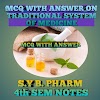PHARMACOGNOSY AND PHYTOCHEMISTRY – I PRACTICAL
ANALYSIS OF GELATIN BY CHEMICAL TEST
EXPERIMENT NO.6
Aim: Analysis of Gelatin by chemical tests.
Reference: 1. Mayur R. Bhurat, Md. Rageeb Md. Usman,
Sanjay A. Nagdev, Practical Pharmacognosy & Phytochemistry – I, Published
by S. Vikas And Company (Medical Publisher) page. No. 23 – 24.
2. Dr. K.R Khandelwal, Textbook of Practical Pharmacognosy, Pubished by Nirali Prakashan, Sixth Edition, page. No. 162.
Requirements:
Apparatus: Test tubes, Beaker, Holder, Burner, Water bath,
Tripod stand, Copper gauze etc.
Chemicals: NaOH, CuSO, Million’s reagent, Tannic acid,
Tri-nitrophenol, Picric acid etc.
Theory:
Biological Source: Gelatin
is a mixture of peptides and proteins produced by partial hydrolysis of
collagen extracted from the skin, bones, and connective tissues of animals such
as domesticated cattle, chicken, pigs, and fish.
OR
Gelatin
is a product obtained by the partial hydrolysis of collagen, derived from the
skin, white connective tissue, tendons, ligament and bones of ox (Bostourus Linn.), sheep (Ovis aries
Linn), etc.
Family: Bovidae.
Description:
Color: Colorless
to faint yellow.
Odor:
Characteristics.
Taste: Salty,
meat like.
Shape:
Available as flakes, translucent sheets, or coarse or fine powder.
Solubility: It is insoluble in cold but soluble in hot water.
Chemical Constituents: Gelatin mainly consists of protein glutin, which on hydrolysis gives a mixture of amino acids like glycine, alanine, leucine, aspartic acid, arginine, lysine, isoleucine, valine, tyrosine, cystine, cysteine, glutamic acid, argenine, etc. Adhesive property of gelatin is due to the presence of glutin.
Uses: In capsule preparation, As culture medium in Bacteriology, In making suppositories, Source of protein in nutritional experiments, As a substitute for blood plasma, used as suspending agent, coating agent, and binding agent, also widely used in food products and photographic emulsions and microencapsulation of drugs.
Chemical Test of
Gelatin:
|
SR.NO |
CHEMICAL TEST |
OBSERVATION |
INFERENCE |
|
A)
|
Preliminary
Test.
1. Colour
|
White
White to slight yellow and sometime grayish in color |
Acacia, Tragacanth, Agar, Starch.
Gelatin |
|
2. Odour
|
Odorless |
Acacia, Tragacanth, Agar,
Starch, Gelatin |
|
|
3. Taste |
Mucilaginous
|
Agar, Acacia, Tragacanth,
Starch, Gelatin |
|
|
B) |
Solubility
in Alcohol |
Soluble |
Balsams, Aloes
|
|
Insolube |
Acacia, tragacanth, agar,
gelatin |
||
|
D) |
Insoluble in Alcohol. 1. Mount in alcohol & irrigate with water |
Particles swell and ultimately
dissolve or become diffused |
Tragacanth, agar, gelatin.
|
|
E) |
Confirmatory
Test: |
||
|
1.
Biuret test: Take 3 ml test solution , add 4% NaOH and few
drop of 1% CuSO |
Violet or pink color observed |
Protein is present
|
|
|
2. When sample is heated with
soda lime in dry test tube |
Evolution of ammonia |
Gelatin is present |
|
|
3. Sample treated with tannic
acid solution. |
buff white precipitation
observed |
Gelatin is present |
|
|
4. Sample aqueous solution
treated with tri-nitrophenol |
yellow precipitation |
Gelatin is present |
|
|
|
5. Sample solution treated with
picric acid |
yellow precipitation |
Gelatin is present |
Result: The given Sample Crude drug was identified by
performing the chemical test and the sample was found to be Gelatin.
















0 Comments
Please do not enter any spam link in the comment box.